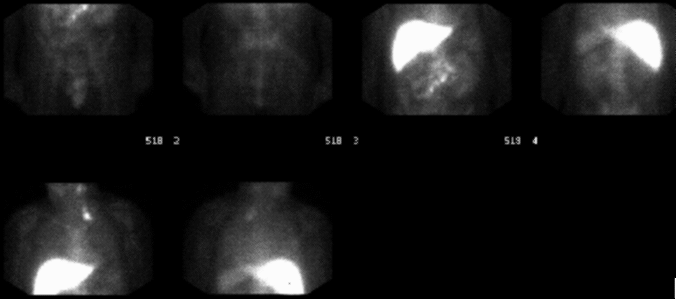Case Author(s): Jeff Chesnut, D.O. and Keith Fischer, M.D. , 7/28/99 . Rating: #D3, #Q4
Diagnosis: Metastatic prostate carcinoma
Brief history:
52 year old male with prostate carcinoma.
Images:

Anterior and posterior spot views are shown
View main image(pr) in a separate image viewer
View second image(pr).
Magnified spot views over the abdomen and
pelvis are shown.
View third image(pr).
Magnified spot views over the chest and neck are
shown
Full history/Diagnosis is available below
Diagnosis: Metastatic prostate carcinoma
Full history:
This patient is a 52 year old male with prostate carcinoma who is
pre-decision for definitive therapy. At the time of this study, he was on
hormonal therapy only. He has a Gleason 6 tumor with a PSA value of
48ng/ml. A CT scan at an outside hospital (not available) described mildly
enlarged nodes in the retroperitoneum at the level of the left renal hilum.
Radiopharmaceutical:
5.4 mCi In-111 capromab pendetide
Findings:
There is the expected activity in the blood pool, liver, bone marrow, and
gastrointestinal tract. Abnormal antibody uptake is seen in the left
supraclavicular region, the retroperitoneal region at the level of the left
renal hilum and inferiorly extending down the right common common iliac
lymph node chain. There is also abnormal activity in the prostate area as
expected in this patient whose prostate is still in situ. There is abnormal
uptake in the left internal iliac nodes.
Discussion:
Capromab pendetide (ProstaScint) is a murine monoclonal
antibody directed against prostate specific membrane
antigen (PSMA). It reportedly has an affinity for
approximately 95% of adenocarcinomas of the prostate.
Its primary use is the detection of soft tissue metastases of
prostate carcinoma. For the detection of bone metastases,
bone scintigraphy is the preferred imaging study of choice.
Normal biodistribution of Capromab Pendetide includes
the most intense activity in the liver, spleen, bone marrow,
and blood pool. Varying levels of activity are seen in the
kidneys, nasopharynx, spermatic cord and genitalia.
"In primary disease, Capromab Pendetide imaging should
be reserved for use in patientswith negative bone scans
who are at high risk for metastatic disease based on clinical
stage, Gleason score, and PSA level. A negative scan does
not eliminate the need for a staging lymph node dissection
but should encourage further pursuit of local treatment
options. A positive scan in this high risk setting would
support proceeding with systemic treatment options or
watchful waiting." (Haseman and Reed; Nuclear Medicine
Annual 1998., ed. Leonard Freeman, M.D.;
Lippincott-Raven Publishers, Philadelphia, 1998.)
Major teaching point(s):
1. Capromab Pendetide (ProstaScint) is used for the
detection of soft tissue metastases from prostate carcinoma
in high risk patients.
2. Capromab Pendetide should not be the primary imaging
modality for the detection of metastatic bone lesions.
ACR Codes and Keywords:
- General ACR code: 84
- Genitourinary System:
844. "Prostate"
References and General Discussion of (Anatomic field:Genitourinary System, Category:Effect of Trauma)
Search for similar cases.
Edit this case
Add comments about this case
Return to the Teaching File home page.
Case number: pr002
Copyright by Wash U MO

